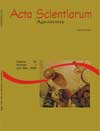<b>Precocity of soybean cultivars on cultivation systems with corn in Areia, Paraíba State</b> - DOI: 10.4025/actasciagron.v31i3.675
Keywords:
Glycine max (L.) Merrill, Zea mays L., intercrop, inoculation
Abstract
The objective of this work was to evaluate the effect of cultivation systems, associated or not with an inoculant, in the precocity of soybean cultivars at the green grain growth stage. The research was led in field conditions, in CCA/UFPB, Areia-PB with an experimental design in randomized blocks, in sub-subdivided plots (3 x 2 x 2), three cultivars (Pati, JLM 004 and Pirarara), with and without inoculation and in systems of single cultivation and intercropped with corn, with four replicates. Cultivar precocity was evaluated through the numbers of days until emergence, flowering, and maturation, the reproductive period and the number of harvested plants. The cultivar JLM 004 features the longest emergence period, but it develops to the other reproductive phases in less time and with lower number of plants at harvest; cultivar Pirarara presents the longest time for the reproductive cycle, the same as cultivar Pati, when intercropped and with inoculation; the intercrop system and the inoculation increase the number of days for the maturation of cultivar Pati, while the monocrop system and without inoculation extends the necessary time for the maturation of cultivar Pirarara.Downloads
Download data is not yet available.
Published
2009-06-23
How to Cite
Viana, J. S., Bruno, R. L. A., Mendonça, J. L., Gonçalves, E. P., Alves, E. U., & Braga Júnior, J. M. (2009). <b>Precocity of soybean cultivars on cultivation systems with corn in Areia, Paraíba State</b> - DOI: 10.4025/actasciagron.v31i3.675. Acta Scientiarum. Agronomy, 31(3), 481-488. https://doi.org/10.4025/actasciagron.v31i3.675
Issue
Section
Crop Production
DECLARATION OF ORIGINALITY AND COPYRIGHTS
I Declare that current article is original and has not been submitted for publication, in part or in whole, to any other national or international journal.
The copyrights belong exclusively to the authors. Published content is licensed under Creative Commons Attribution 4.0 (CC BY 4.0) guidelines, which allows sharing (copy and distribution of the material in any medium or format) and adaptation (remix, transform, and build upon the material) for any purpose, even commercially, under the terms of attribution.
2.0
2019CiteScore
60th percentile
Powered by 

2.0
2019CiteScore
60th percentile
Powered by 



















































